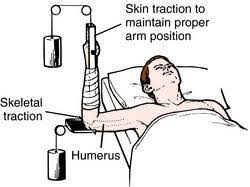A nurse is discussing the differences between skeletal and skin traction with a newly licensed nurse. Which of the following statements by the newly licensed nurse indicates understanding?
Clients with skin traction have more mobility than those with skeletal traction.
Clients with skin traction have more discomfort than those with skeletal traction.
Skeletal traction is more appropriate than skin traction for reducing a fracture.
Skeletal traction has less risk for infection than skin traction.
The Correct Answer is C
Choice A reason:
Skin traction is indeed less restrictive than skeletal traction, allowing for more mobility. It is applied using bandages or adhesive material to the skin, which can be removed or adjusted more easily than the pins or screws used in skeletal traction. This type of traction is typically used for short-term treatment before surgery or when the injury is less severe.
Choice B reason:
Discomfort levels can vary depending on the individual and the specific circumstances of the traction. However, skin traction is generally considered to be less painful than skeletal traction because it is less invasive and applies less force. Skeletal traction, which involves the insertion of pins or wires directly into the bone, is likely to cause more discomfort due to the invasive nature of the procedure.
Choice C reason:
Skeletal traction is more appropriate for reducing fractures, especially in cases where a greater force is needed to align the bones. It involves the surgical insertion of pins or wires directly into the bone, allowing for a stronger and more stable pull that is necessary for the realignment of complex fractures.
Choice D reason:
Skeletal traction carries a higher risk of infection compared to skin traction because it is more invasive. The insertion of pins or wires into the bone creates a potential entry point for bacteria, which can lead to infection at the site of insertion.

Nursing Test Bank
Naxlex Comprehensive Predictor Exams
Related Questions
Correct Answer is A
Explanation
Choice a) Raloxifene:
Raloxifene is part of a class of drugs known as selective estrogen-receptor modulators (SERMs). It works by imitating the beneficial effects of the hormone estrogen on your bones, helping to prevent bone loss and improve density. Therefore, it is used in the prevention and treatment of osteoporosis.
Choice b) Calcitonin:
Calcitonin is a hormone that a person’s thyroid gland produces. It helps regulate the amount of calcium in the body. For the treatment of postmenopausal osteoporosis, scientists typically extract calcitonin from salmon. This is because salmon calcitonin has a much higher potency than human calcitonin. Osteoclasts are cells in the body that degrade bone. Calcitonin can inhibit osteoclasts. This helps slow the loss of bone density and increases bone mass, hindering the progression of osteoporosis.
Choice c) Allopurinol:
Allopurinol is primarily used to treat gout and certain types of kidney stones. It is not typically used in the prevention or treatment of osteoporosis.
Choice d) Levothyroxine:
Levothyroxine is used to treat hypothyroidism (underactive thyroid). It is not typically used in the prevention or treatment of osteoporosis. However, if you are prescribed levothyroxine you should have regular blood tests, at least once a year, to ensure your thyroid hormone levels are not too high. Continuous high thyroid hormone levels may lead to developing or worsening of low bone density and osteoporosis.
Correct Answer is B
Explanation
Choice A reason:
The statement that the prosthesis will be adjustable depending on what shoe you are wearing is not accurate. Prostheses are custom-made to fit the individual and are not typically adjustable to different shoe types. The fit and alignment of the prosthesis are crucial for comfort and function, and these are not dependent on the footwear.
Choice B reason:
It is true that clients will need to do special exercises in advance of getting their prosthesis. These exercises are designed to strengthen the remaining limb and prepare the body for the use of a prosthesis. They are an essential part of rehabilitation and help ensure the best possible outcome for the client.
Choice C reason:
Clients are not fitted for their prosthesis at the time of surgery. Fitting for a prosthesis typically occurs after the residual limb has sufficiently healed, which can take several weeks. The fitting process involves careful measurement and customization to ensure the prosthesis will be comfortable and functional.
Choice D reason:
While a special dressing is applied postoperatively, its primary purpose is not to cushion the prosthesis. Initially, dressings are used to protect the surgical site, control swelling, and promote healing. The prosthesis is fitted after the residual limb has healed, and at that time, different types of socket liners may be used for cushioning.
Whether you are a student looking to ace your exams or a practicing nurse seeking to enhance your expertise , our nursing education contents will empower you with the confidence and competence to make a difference in the lives of patients and become a respected leader in the healthcare field.
Visit Naxlex, invest in your future and unlock endless possibilities with our unparalleled nursing education contents today
Report Wrong Answer on the Current Question
Do you disagree with the answer? If yes, what is your expected answer? Explain.
Kindly be descriptive with the issue you are facing.
